15 Best Things to do in Arches National Park, Utah
What to Do in Arches National Park: Are you looking for something to do in Arches National Park? Or perhaps you’re seeking something to do at Arches National Park? Arches National Park is a small but powerful national park located just 6 miles outside of Moab, Utah. There’s something for everyone on this list of Arches National Park Attractions and Best Things to Do in Arches National Park.

Thank you for supporting this website written by an American. This post may contain affiliate links. This means I earn a small commission on these links at no extra cost to you.
National Park Entrance Fees
To enter the National Parks, you’ll need to pay an entrance fee or have a National Parks Pass also known as American the Beautiful Pass.

It costs $80 for a yearly America the Beautiful Pass. This gives you access to all national parks and federal areas that charge fees. The America the Beautiful Pass is well worth it!
I purchased my first one in 2016 and it’s such a money-saver! Plus 10% of sale proceeds go to the National Park Foundation.
Tips for Visiting Grand Teton National Park
Grand Canyon National Park is perfect for outdoor enthusiasts. There is something for everyone on this list and for different fitness levels. Also, note that it is dry and hot (in the summer), and make sure you know what you are getting into before you start. Here are a few tips for visiting the Grand Canyon:
- Bring a reusable water bottle and lots of water! Remember you are in the sun and you will need to drink lots of water. I love my LifeStraw Filtered Water Bottle. I can refill this bottle anywhere and it comes with a carabiner to connect it to my daypack.
- Check the Weather – days over 100 degrees are very common. Make sure to check.
- Hiking boots or sandals that will protect your feet! I love good shoes. I need all the support and help I can get. I actually love these sandals for hiking and also love these hiking boots.
- Bring hiking poles for balance and to protect your knees. I know many experienced hikers (and even amateur ones) think that hiking poles are for old people who lose their balance. Actually, hiking poles can help when going down steep inclines or when scrambling over rocks. They are great to hike with even for the most experienced hiker.
- Wear a sunhat. I feel like this whole post is about how high you are in the mountains and how much closer you are to the sun but it is so true. At elevation, you are closer to the sun and more likely to burn. Wear sun protection such as a sun hat and sunscreen.
- Be aware of the wildlife. This is the Southwest and you will need to watch out for snakes and other wildlife such as moose or a bear. Please stay away from wildlife and do not feed them. I recommend carrying bear spray as well.
- Start Early – If you want to avoid the traffic and the heat you will need to start your hike early. That way it will be nice and cool and the smog will not affect you either.
- Leave no trace. If you are new to the concept of Leave No Trace it is all about preserving the environment to ensure it is in the same or better condition when you leave it. This means that you should stick to the trails and carry out everything that you carried in. This is a great explanation of the Leave No Trace principles!
- Water shoes are great for water hikes– If you don’t have a pair, I highly suggest it as they are affordable. I have an article on the pros and cons of several pairs of water shoes.
- Bring Bug Spray and a snack: Be sure to bring everything you need including a snack like a protein bar plus BUG SPRAY.
Where to stay near Grand Canyon National Park
The Grand Canyon makes for a great weekend escape. Fresh air, beautiful scenery and being in nature does a world of good for the soul. I recommend staying as close to the park as possible and even treating yourself with a cabin with a spa pool to relax at night.
- There are lots of fantastic Airbnbs near the Grand Canyon. I have made a list of the best airbnbs around the park wherever you decide to stay. You can also check out my post on Where to Stay near the Grand Canyon to find the perfect hotel for any budget.
If you are taking a road trip remember to reserve a car in advance using Discover Cars .
National Park Entrance Fees
To enter the National Parks, you’ll need to pay an entrance fee or have a National Parks Pass also known as American the Beautiful Pass.

It costs $80 for a yearly America the Beautiful Pass. This gives you access to all national parks and federal areas that charge fees. The America the Beautiful Pass is well worth it!
I purchased my first one in 2016 and it’s such a money-saver! Plus 10% of sale proceeds go to the National Park Foundation.
Tips for Visiting Grand Teton National Park
Grand Canyon National Park is perfect for outdoor enthusiasts. There is something for everyone on this list and for different fitness levels. Also, note that it is dry and hot (in the summer), and make sure you know what you are getting into before you start. Here are a few tips for visiting the Grand Canyon:
- Bring a reusable water bottle and lots of water! Remember you are in the sun and you will need to drink lots of water. I love my LifeStraw Filtered Water Bottle. I can refill this bottle anywhere and it comes with a carabiner to connect it to my daypack.
- Check the Weather – days over 100 degrees are very common. Make sure to check.
- Hiking boots or sandals that will protect your feet! I love good shoes. I need all the support and help I can get. I actually love these sandals for hiking and also love these hiking boots.
- Bring hiking poles for balance and to protect your knees. I know many experienced hikers (and even amateur ones) think that hiking poles are for old people who lose their balance. Actually, hiking poles can help when going down steep inclines or when scrambling over rocks. They are great to hike with even for the most experienced hiker.
- Wear a sunhat. I feel like this whole post is about how high you are in the mountains and how much closer you are to the sun but it is so true. At elevation, you are closer to the sun and more likely to burn. Wear sun protection such as a sun hat and sunscreen.
- Be aware of the wildlife. This is the Southwest and you will need to watch out for snakes and other wildlife such as moose or a bear. Please stay away from wildlife and do not feed them. I recommend carrying bear spray as well.
- Start Early – If you want to avoid the traffic and the heat you will need to start your hike early. That way it will be nice and cool and the smog will not affect you either.
- Leave no trace. If you are new to the concept of Leave No Trace it is all about preserving the environment to ensure it is in the same or better condition when you leave it. This means that you should stick to the trails and carry out everything that you carried in. This is a great explanation of the Leave No Trace principles!
- Water shoes are great for water hikes– If you don’t have a pair, I highly suggest it as they are affordable. I have an article on the pros and cons of several pairs of water shoes.
- Bring Bug Spray and a snack: Be sure to bring everything you need including a snack like a protein bar plus BUG SPRAY.
Where to stay near Grand Canyon National Park
The Grand Canyon makes for a great weekend escape. Fresh air, beautiful scenery and being in nature does a world of good for the soul. I recommend staying as close to the park as possible and even treating yourself with a cabin with a spa pool to relax at night.
- There are lots of fantastic Airbnbs near the Grand Canyon. I have made a list of the best airbnbs around the park wherever you decide to stay. You can also check out my post on Where to Stay near the Grand Canyon to find the perfect hotel for any budget.
If you are taking a road trip remember to reserve a car in advance using Discover Cars .
Tips for Visiting in Arches National Park
Arches is perfect for outdoor enthusiasts. There is a hike for everyone on this list and for different fitness levels. Also, note that it is dry and hot (in the summer), and make sure you know what you are getting into before you start. Here are a few tips for visiting Arches:
- Bring a reusable water bottle and lots of water! Remember you are in the sun and you will need to drink lots of water. I love my LifeStraw Filtered Water Bottle. I can refill this bottle anywhere and it comes with a carabiner to connect it to my daypack.
- Check the Weather – days over 100 degrees are very common. Make sure to check.
- Hiking boots or sandals that will protect your feet! I love good shoes. I need all the support and help I can get. I actually love these sandals for hiking and also love these hiking boots.
- Bring hiking poles for balance and to protect your knees. I know many experienced hikers (and even amateur ones) think that hiking poles are for old people who lose their balance. Actually, hiking poles can help when going down steep inclines or when scrambling over rocks. They are great to hike with even for the most experienced hiker.
- Wear a sunhat. I feel like this whole post is about how high you are in the mountains and how much closer you are to the sun but it is so true. At elevation, you are closer to the sun and more likely to burn. Wear sun protection such as a sun hat and sunscreen.
- Be aware of the wildlife. This is the Southwest and you will need to watch out for snakes and other wildlife such as moose or a bear. Please stay away from wildlife and do not feed them.
- Start Early – If you want to avoid the traffic and the heat you will need to start your hike early. That way it will be nice and cool and the smog will not affect you either.
- Leave no trace. If you are new to the concept of Leave No Trace it is all about preserving the environment to ensure it is in the same or better condition when you leave it. This means that you should stick to the trails and carry out everything that you carried in. This is a great explanation of the Leave No Trace principles!
- Water shoes are great for water hikes– If you don’t have a pair, I highly suggest it as they are affordable. I have an article on the pros and cons of several pairs of water shoes.
- Bring Bug Spray and a snack: Be sure to bring everything you need including a snack like a protein bar plus BUG SPRAY.
Arches Attractions you cannot miss!
Arches National Park Scenic Drive
If you’re simply just driving through the park and time is a luxury, making a stop at all the designated viewpoints and points of interest is really the best way to get the most of your experience. The scenic drive of Arches National Park is a great place to spend a couple of hours to see the sights and to take pictures.

A nice area to visit is the Windows Section. There are several impressive arches here and they can easily be reached via accessible trails. Another iconic arch is the Delicate Arch, make sure to bring binoculars to see this majestic sight. Don’t miss the best roadside stops inside this national park filled with natural stone arches.
Park Avenue Trail
The Park Avenue Trail is one of the first major attractions within Arches National Park. It is a one-mile trail that follows the bottom of a canyon at the feet of some of the park’s gigantic and well-known monoliths. When you are done enjoying the views, follow the stone steps dropping down to the canyon floor and then continue along a dirt path that gently descends the wash.

As you progress the dirt path gives way to slick rock and sand, marked with rock cairns. Huge sandstone formation topped with towers, spires and other-worldly rock formation towers above the trail. Closer-at hand, Junipers, sage and Mormon tea grow amid the rocky landscape. Take the Park Avenue Trail and enjoy the view of the canyons on the horizon.
Hike to Delicate Arch
Delicate Arch is one of the most iconic arches to see in the Arches National Park as well as it stands as the symbol of the state of Utah. Aside from going on a drive while taking photos, hiking to Delicate Arch is one way of experiencing the greatness of this arch. The Delicate Arch trail often surprises visitors by being more difficult than they’d expected. The entire trail is sun-exposed, offering little shade, and has multiple steep sections.
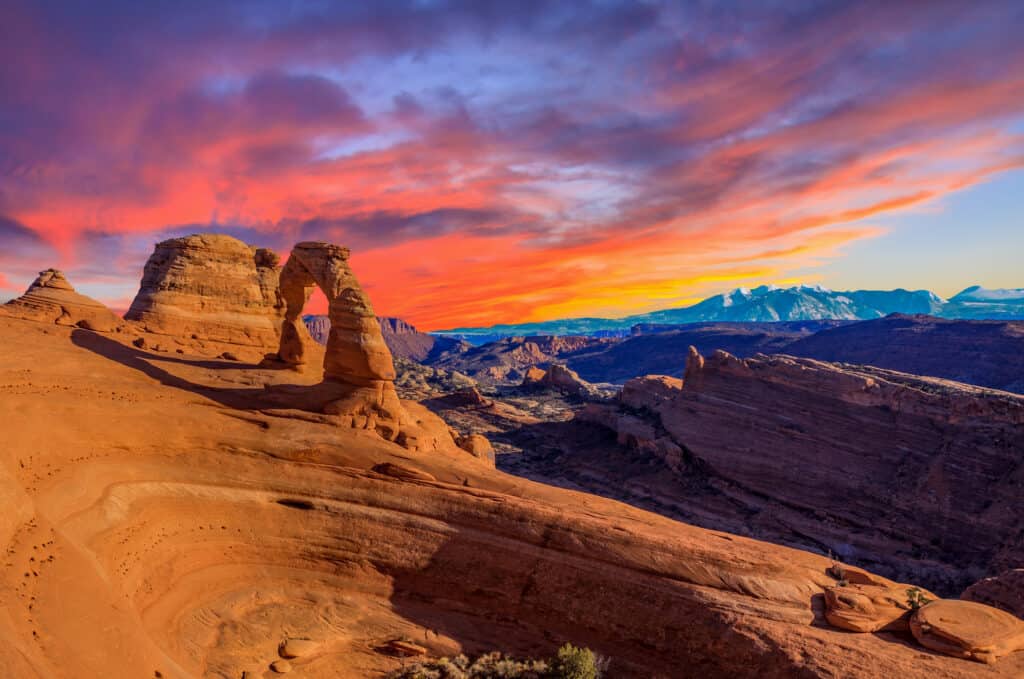
On the way, be expected to see petroglyphs, the Frame Arch, and do some red rock scrambling. After 1.5 miles of moderately difficult hiking, you’ll be rewarded with an unbeatable view, and a chance to see the arch up close. Hiking to Delicate Arch will be worth it when the sunsets. So pack your hiking gear and get ready to hike the Delicate Arch.
Devil’s Garden
Devil’s Garden, named and famed for its fin shaped rock formation is one of the longest and most difficult trails in Arches National Park. It’s also one of the most fun trails to hike. Devils Garden provides a brief introduction to the kind of slick rock walking and route finding over a trail-less landscape typical of most backcountry routes in the Escalante region.

Since the landscape features, such as pour-offs and cliffs, are in miniature here, obstacles are minor. Once you get past the early sections you’ll be scrambling up and over long, narrow sandstone fins, ducking under and crawling through existing arches, and trekking through ruggedly beautiful backcountry that few of the more casual tourists in Arches will ever get to see.
Landscape Arch
Akin to the hike to Delicate Arch, Landscape Arch is also a must-see feature of the Arches National Park. Unlike the Delicate Arch, the Landscape Arch has an easy trail to hike on. It is flat and double-wide all the way. Landscape Arch has an opening spanning an incredible 306 feet, which may make it the longest stone span in the world. On the geologic time scale, Landscape Arch is a senior citizen among arches in the park. It’s also famous for the extreme slenderness of its stone span.
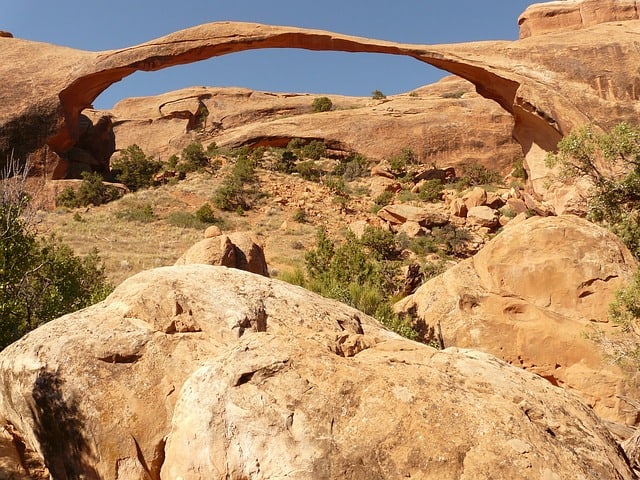
The trail is relatively flat with hard packed surfaces to walk on. There is no significant elevation gain, only moderate hills, up and down. The trail meanders through tall fins to a spectacular view of Landscape Arch. Along the way, you’ll see side trails to Pine Tree and Tunnel Arches. Once your eyes come to accept that this improbable arch is actually standing, you are free to hike back the way you came. If you are eager for more, six other arches are farther up the trails beyond Landscape Arch. Landscape Arch is a great place for sightseeing and admiring the long beautiful arches.
Visit Double Arch
Wonders never cease in Arches National Park. For proof, hike Double Arch Trail, which visits two grand arches joined at a common pillar at a 90-degree angle. Double Arch is an incredible formation of arches within the Windows area of Arches National Park, an area with the largest concentration of natural arches in the entire world. Double Arch takes its name because of it consists of two arches that share the same stone as a foundation for both of their outer legs.

Double Arch was formed by downward water erosion from atop the sandstone, rather than from side-to-side water erosion. At just one half-mile round trip and with almost no elevation change this hike is perfect for children and adults of all skill levels. As you hike toward Double Arch, take notice of the numerous other small arches and openings in the rocks around the arch. Immediately west (left) of the trail is a formation known as The Parade of Elephants, a series of small arches and towers that resemble a herd of elephants. A trip to the double arch is sure to be worth double your time.
The Windows and Turret Arch
When you take a scenic drive around Arches National Park, one of the most iconic places to drive by is The Window. The Windows trail offers more bang-for-its-buck than most of the other trails in Arches National Park. The trail visits North and South Window Arches, as well as Turret Arch all in a short less-than-a-mile outing. This one-mile loop visits three impressive arches in close vicinity.

The North and South Window Arches form openings in the same sandstone fin, while Turret Arch stands within a more castle-like formation. The hike to the arches is easy and suitable for most, while an optional loop back to the trailhead that goes behind North and South Windows offers just enough scrambling and fun that kids will love the small challenges. Visiting The Windows and the Turret Arch is an absolute must-do whenever you are in Arches National Park.
Visit Sand Dune Arch
If you have kids and are visiting Arches National Park, Sand Dune Arch would be one of the top recommendations to stop at. A short hike, shade, sand for the kids to play in, and a nice arch, this hike has it all! Sand Dune Arch, as its name implies, has quite a bit of sand around it, the accumulation of wind-driven sand at its base. The arch sits in the shade for most of the day, flanked by two large sandstone fins.

Though the hike to Sand Dune Arch is relatively small, there are many things to see along with the Sand Dune Arch. From the Sand Dune Arch junction, continue along to the loop junction in about 0.3 miles. Going at the loop junction, Broken Arch comes into view. This is a great place for the kids (and adults) to take a break from hiking up and down those hot trails as Sand Dune Arch has moderate shade. It is definitely a must see arch when visiting Arches National Park as a family.
See Balanced Rock
Balanced Rock is exactly what its name implies: a large rock, balanced upon a narrower pedestal of stone beneath it. This 1/3 of a mile loop circles one of the Arches’ most prominent landmarks. Balanced Rock is a defiant 55-foot tall block of Estrada Sandstone that rests on a narrow stand of Dewey Bridge Rock. As you approach Balanced Rock from the south, the impressive pillar looks like a ball resting on an old milk bottle.
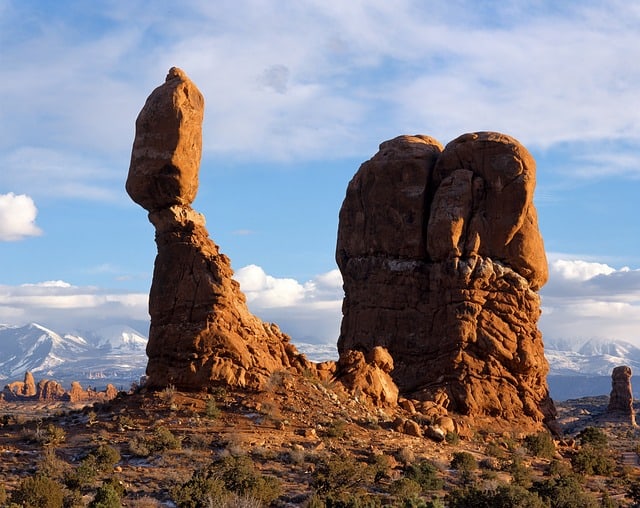
That shape changes as you tour around Balanced Rock, but no matter how you look at it, the rock’s ability to stay put is impressive. A stop here is especially popular with photographers, who suggest a sunset visit when the setting sun gives the rocks a deep, red-orange cast. The trail to Balanced Rock is also used for walking and nature trips year-round. Like the arches, sooner or later they will all fall down and lose its beauty some come to visit Balanced Rock while you still can.
Take a tour of the Fiery Furnace
One of the most popular and most challenging hikes in Arches National Park, Fiery Furnace spans a roughly 2-mile route between towering, maze-like canyon walls. Exploring it is a spectacular, otherworldly experience not without its challenges. There are no trails, signs, or cairns inside the Furnace and GPS units don’t work well in the tall, narrow canyons. This is where the ranger-led tours are important here. They make sure to assist you in the difficult terrain in the Fiery Furnace. If you are an experienced hiker, take a hiker permit to go solo and go wild in the hike.

In the ranger-led hikes, you’ll get a good primer on the region’s geology and history – especially helpful if you plan to do more traveling around the Colorado Plateau – and then you’ll make your way inside the Furnace itself. While there aren’t any established or marked trails inside the Furnace, the rangers have mapped out a route for their guided hikes so in some places you can clearly see some of the stones have been worn down to an effective use-trail. Fiery Furnace is a daring yet exciting place for everyone. Challenges are what make hikes interesting and the hike to the Fiery Furnace is one of them.
Courthouse Towers Viewpoint
Don’t mistake this courthouse for the building of the law. The Courthouse Towers is a collection of tall stone columns that stretch 4,800 feet up from the desert floor in Arches National Park in Utah, USA. The spires include Baby Arch, Three Gossips, Ring Arch and the Tower of Babel. Located 4 miles from the park’s headquarters, the Courthouse Towers is an easy hike to get to. When approaching Courthouse Towers, this freestanding fin appears as an immense mountain of sandstone.
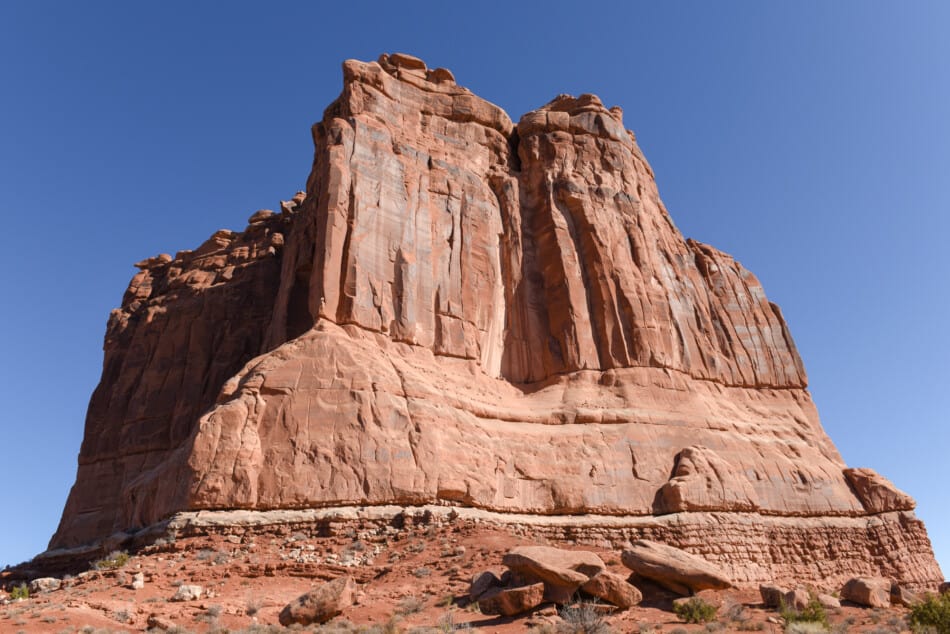
A side view unveils a thin, fragile and gravity defying fin of sandstone. A narrow sliver of salmon-colored Entrada sandstone is all that’s left standing after the surrounding salt bed and softer rock material have been eroded away. The tall stone column makes for a great pictures to take, along with a nice sunset, these stone columns can become something more. Courthouse Towers is easy to get to the area that you will love to see.
Petrified Dunes Belvedere
Be petrified by the cemented sand drifts in the Petrified Dunes. The Petrified Dunes stand today across an area once covered by vast sand dunes. Some 200 million years ago winds from the northwest carried tons of fine-grained sand into this area, creating an immense desert.

Today these dunes have been used for hiking, nature trips and bird watching. What is amazing about the Petrified Dunes is that despite being “petrified”, there is life in the form of the trees on it. You can also view the petrified dunes on a scenic drive, so make sure to bring a camera on the road. The petrified Dunes can surely make you feel petrified with amazement.
La Sal Mountain Viewpoint
Another viewpoint close to the park is the La Sal Mountains. The La Sal Mountains of southeast Utah are familiar to most visitors as the dramatic, often snow-covered backdrop to many of the viewpoints in Arches National Park and the Island in the Sky district of Canyonlands National Park; the peaks themselves are not much visited, despite being close to Moab, and crossed by plenty of roads and trails.
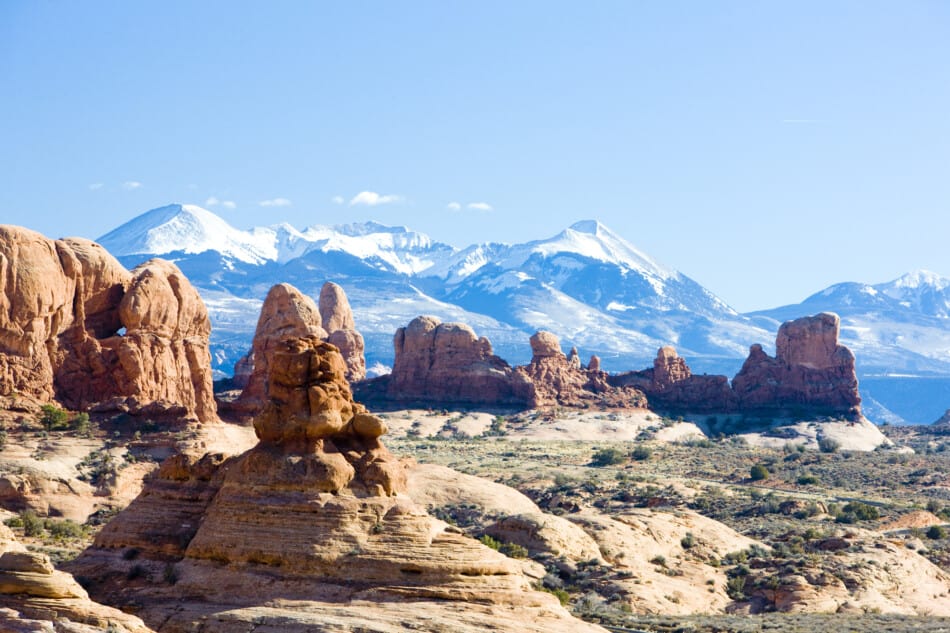
Just from the viewpoint alone can you see the snow-tipped mountains, this is a good place to take photos of with your family and friends. These are the only few tourist attractions that are covered in snow. This is a total must-see whenever you visit the Arches National Park.
Garden of Eden
The Garden of Eden is the first stop on the left as you drive into the Windows Section of Arches National Park. The Garden of Eden is located in Arches National Park near Moab, Utah. With no designated trails it is more of an open hiking area where visitors can explore its various fins and geological structures including Serpentine Arch and Owl Rock.

This underrated piece of the geological wonder is called a viewpoint, but it also acts as an open trail where people can explore the unusual sandstone features on the desert slickrock. This place acts as a birthing ground for many soon-to-be-arches, relatively speaking. You can see medium sized arches and tiny baby arches just starting to form all over this area. The Garden of Eden is an easy to miss part of Arches National Park on the way to the Windows Section. This part can easily be counted as a “Hidden Gem” of the national park.
Recent Posts
15 Tips for Visiting the Grand Canyon in September – 2023 Ultimate Guide
Visiting the Grand Canyon in September is a great time to visit. September is a busy time to visit but the crowds are starting to arrive especially toward the end of the month. I’ve included...
15 Tips for Visiting the Grand Canyon in August – 2023 Ultimate Guide
Visiting the Grand Canyon in August is a great time to visit. August is a busy time to visit but the crowds are starting to arrive especially toward the end of the month. I’ve included all...
